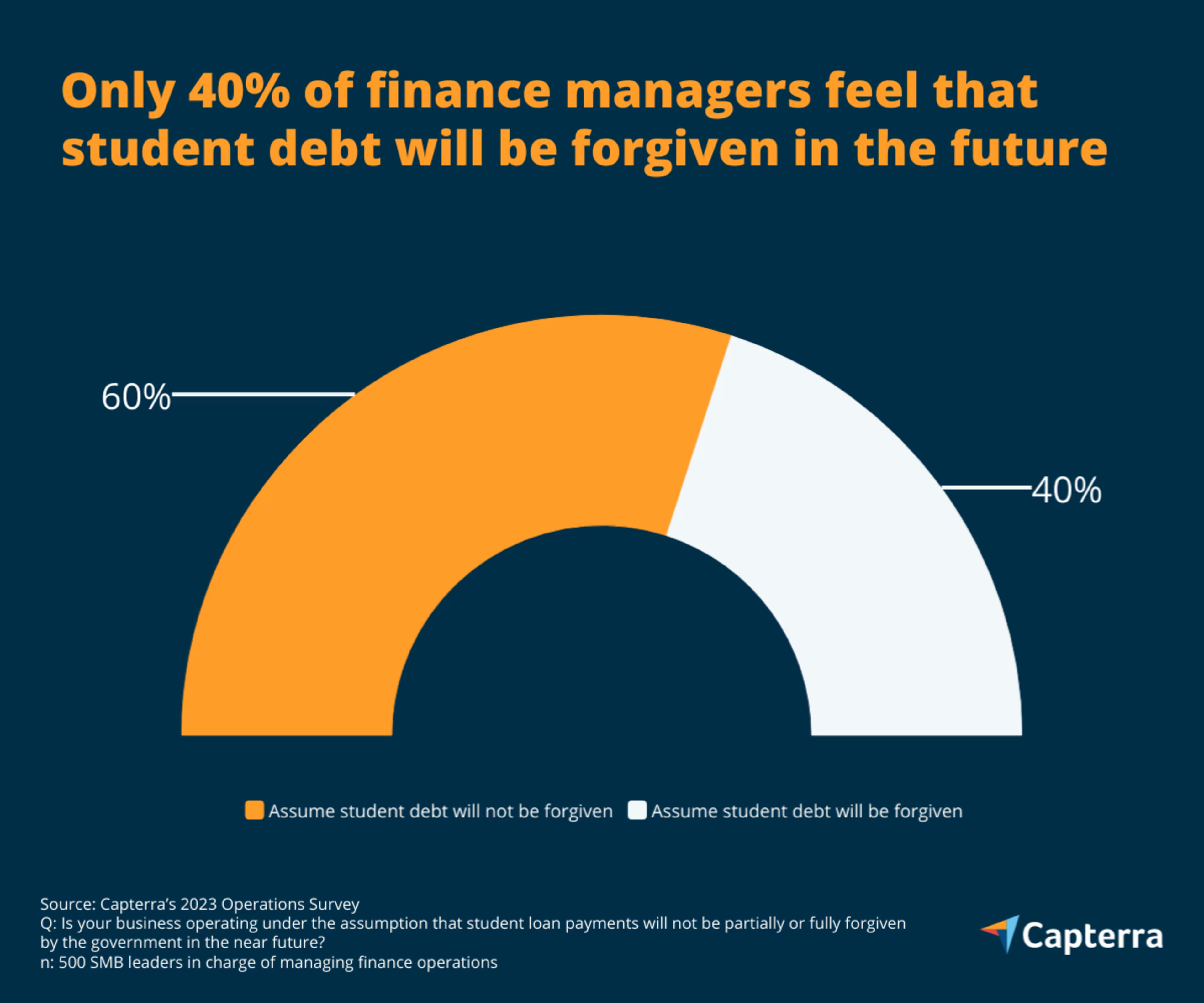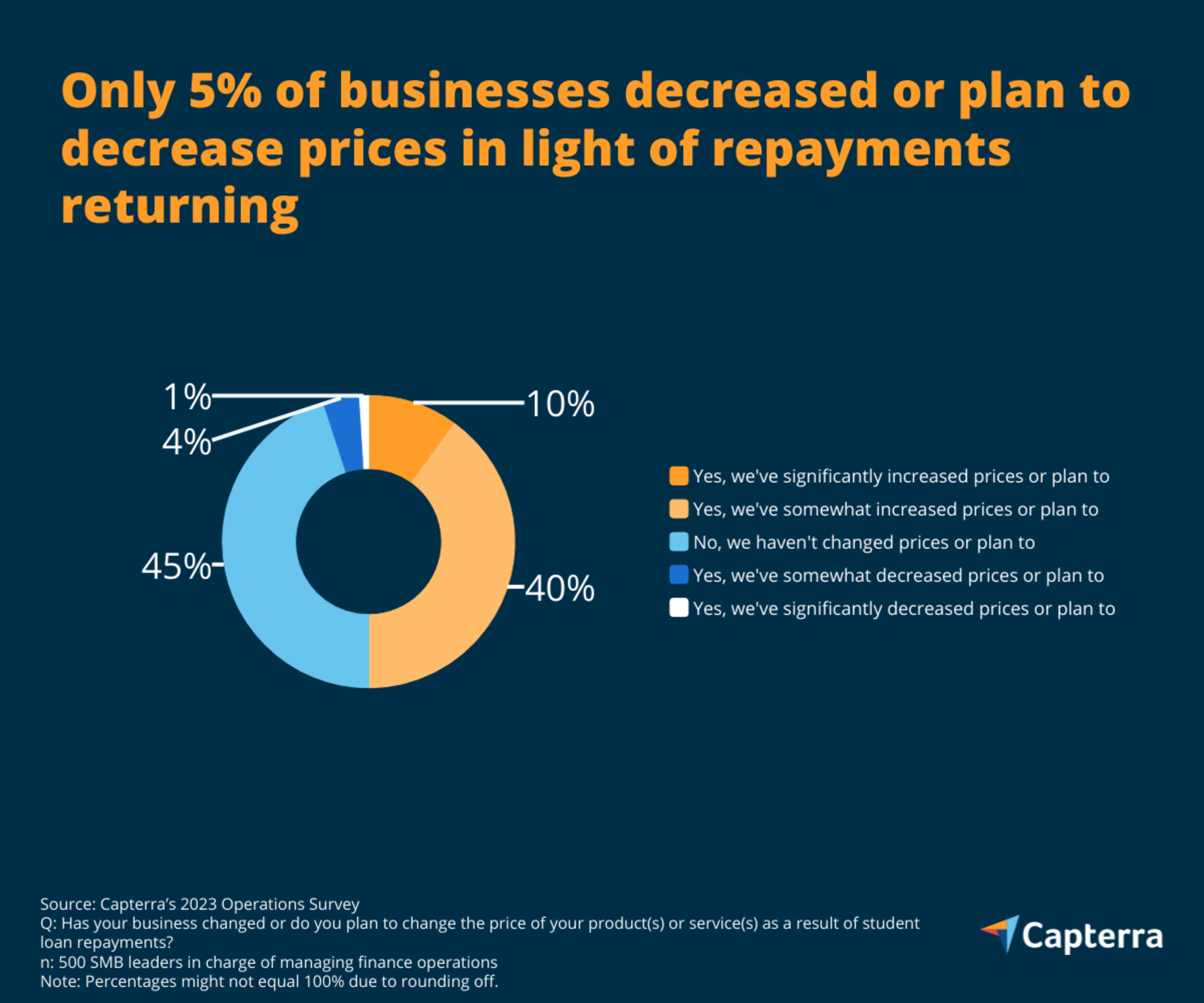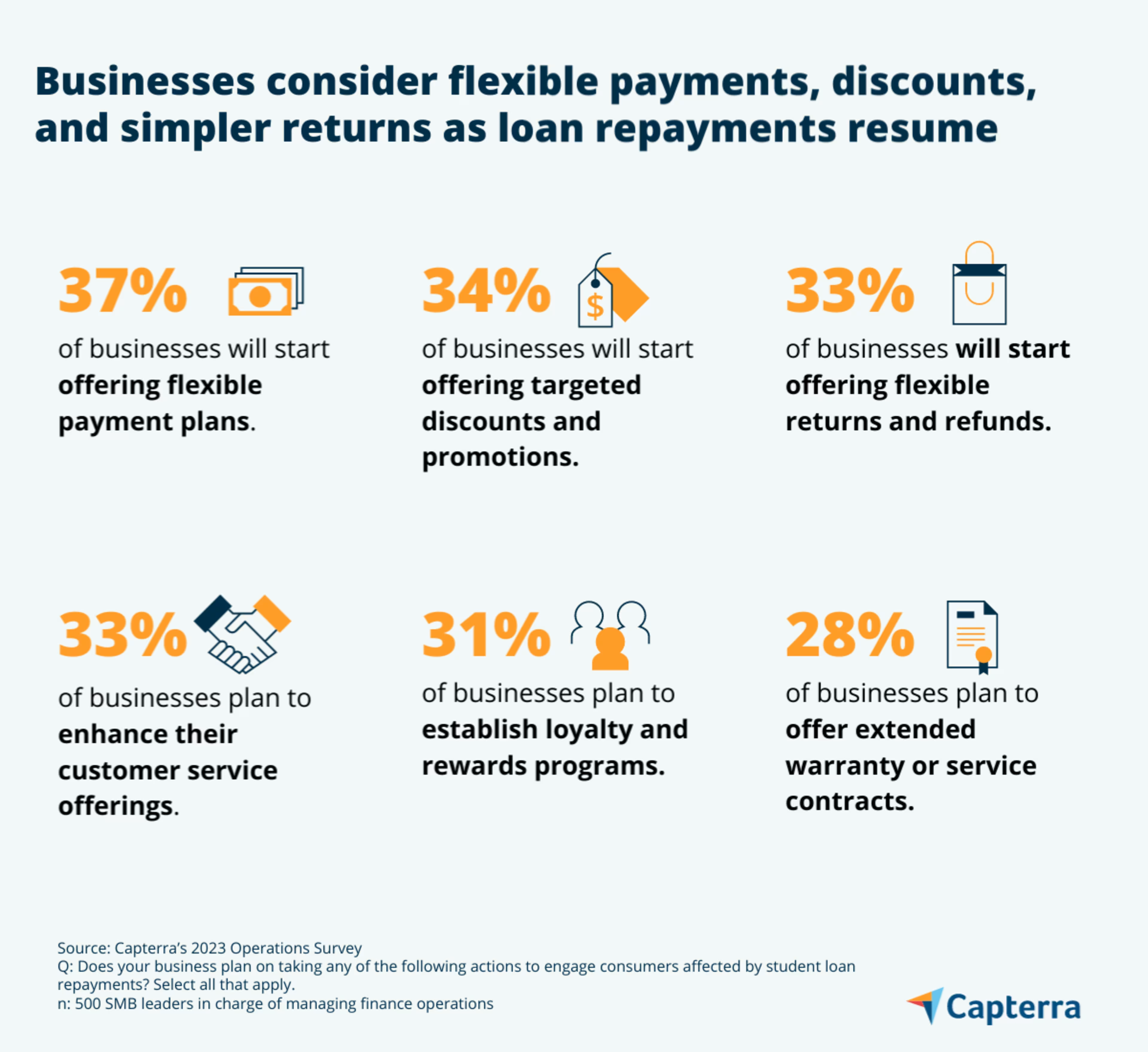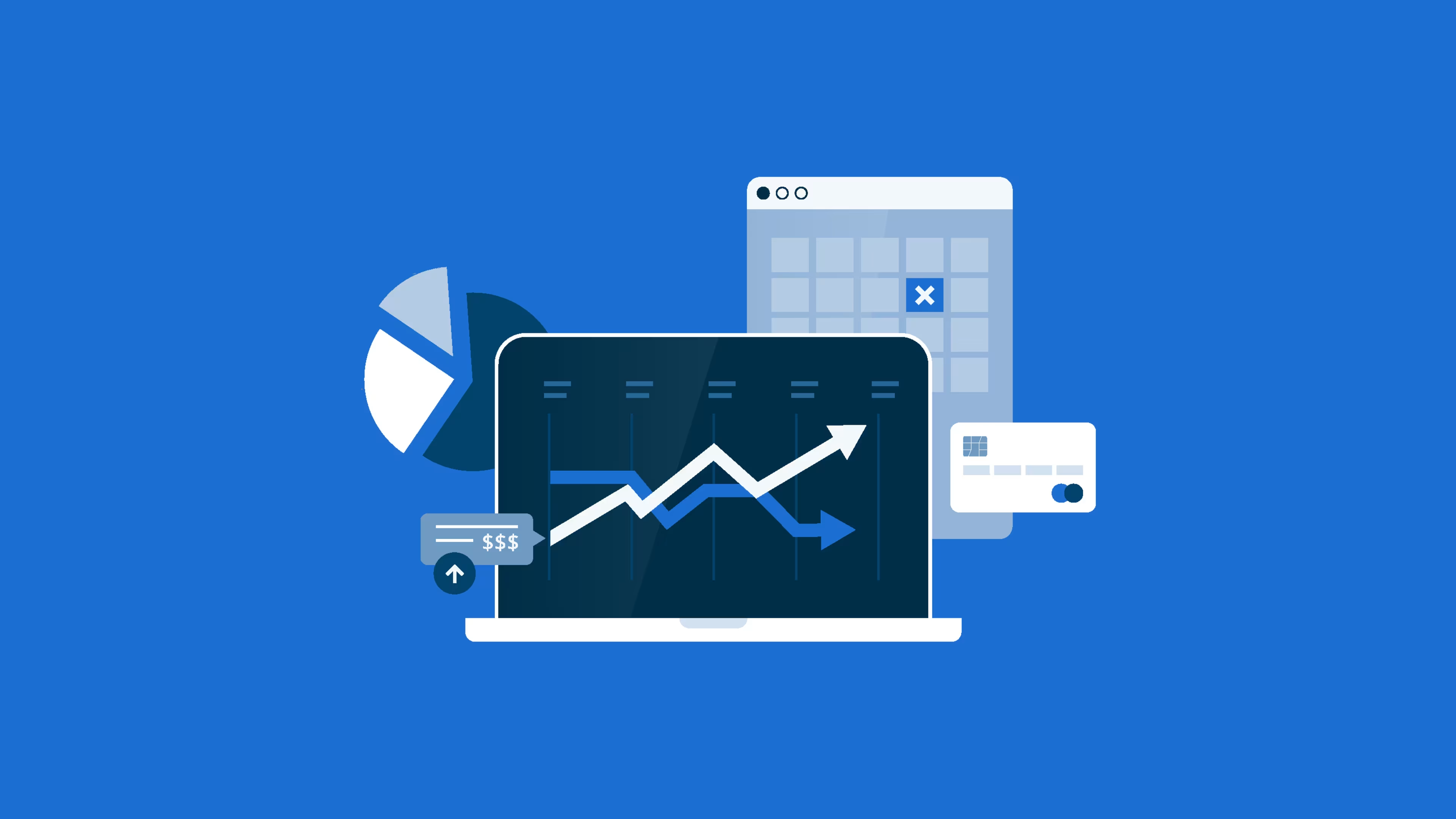83% of businesses plan to explore new ways to reach out to affected customers.
Millions of student-loan borrowers in America resumed repayments last month. While some economists say this will put a relatively small dent in annual consumer spending, households will no doubt feel the squeeze.
As a result, companies are gearing up to make changes. According to Capterra’s 2023 Operations Survey, 83% of B2C finance managers for small and midsize businesses (SMBs) say that they plan on adjusting their company's sales strategies to engage affected consumers.*
If your company neglects to adjust to this change, it will be vulnerable to the long-term economic effects of resumed payments. Our analysis shows how your peers are reacting to the return of student loan repayments, which can help your business make operational changes and adjust your forecasting strategies accordingly.
/ Key findings
76% of finance managers feel that the return of student loan repayments will make a recession more likely in 2024.
50% of businesses have already or plan to raise prices in the foreseeable future, despite student loan repayments resuming.
83% say they plan on engaging affected consumers by offering buy now, pay later plans, targeted discounts, and more.
Recession fears increase as businesses reflect on the return of repayments
After a three-year reprieve, student loan borrowers will now have to set aside an average of ~$337 a month to cover repayments.[1] Whether it's by cutting costs on gas, groceries, or small indulgences, consumers will be looking for ways to stretch their budget.
Though governmental assistance programs—like the Biden administration's SAVE Plan[2]—look to support borrowers by conditionally curbing interest or reducing monthly payments, our survey finds that 60% of businesses say they’re operating under the assumption that student loans will not be partially or fully forgiven in the near future.

The return of student loan repayments will compound with stubborn inflation, high interest rates, and other economic factors to create an even rockier economy for SMBs to navigate in 2024. In fact, 76% of finance managers feel that student loan payment resumptions will make a recession more likely in the coming year.
Although some researchers suggest that a decrease in consumer spending will have a limited impact on the economy, others expect that payment shocks for consumers will be significant, highlighting the fact that there’s no precedent for borrowers getting such a long break from their loans.[3]
/ Our recommendation
Uncertainty is the only certainty there is, something that’s been demonstrated by banking closures last March and recent economic swings. In light of this, your company should revisit and adjust your financial plan to include safeguards and strategies that account for unexpected events that might occur before Q4 closes out and to prepare for the coming year.
Despite loan payments resuming, many businesses are raising prices in light of the economy
Although a little over a third of respondents say that loan payment resumptions will have no impact on their company's earnings in 2024, a surprising amount (46%) expect that revenue will actually increase in the coming year. This might seem counterintuitive—consumer spending will likely decrease in the future, so how are businesses expecting revenue to increase into the new year?
The answer is connected to pricing—despite payments returning, half of respondents say that their company has or plans to raise prices in the foreseeable future. For comparison, only 5% of companies have already dropped prices or plan to drop prices as a result of repayments returning.

Explaining the motivation behind price hikes is less straightforward. Inflation has caused leasing rates to rise, bumped up overhead costs, and increased the cost of raw materials. Naturally, businesses will need to make cost adjustments to account for these factors that are siphoning profits.
Another element is that, even in the face of economic headwinds piling atop one another, consumer demand has shown no signs of stopping in the short-term.[4] However, everything from food costs to subscription prices have increased in the past couple of months, so it’s just a matter of time before financial lag kicks in, forcing consumers to reckon with price hikes that will start cannibalizing household finances.
/ Our recommendation
Over the last few years, loan repayment pauses and stimulus efforts bolstered consumer spending, but now these resources have run dry. Many consumers are turning to credit to keep afloat—something that, sadly, will often keep them in a perpetual loop of debt.[5] Wantonly raising prices, or failing to decrease prices when demand inevitably drops, will end up hurting consumers and your organization in the long run. Keep an eye on any wane in demand for your products, and be extremely prudent as you determine if any pricing adjustments need to be made.
Payment resumptions see businesses making internal and external operational shifts
Beyond pricing, 83% of finance managers say they plan on taking action to engage consumers affected by student loan repayments. Broadly speaking, all these actions look to provide consumers with enhanced customer experience offerings—such as a more flexible stance on returns and refunds—or more ways to make their dollar go the extra mile.
The leading tactic for respondents is offering buy now, pay later plans, which previous research has shown to be especially appealing to consumers during harder economic times. Customers share that they’re more likely to buy from businesses that offer these plans, as they enjoy the convenience and payment flexibility they provide.

For the minority of businesses (19%) that expect loan repayments to negatively impact their company's revenue, they say they plan to adjust internal operations as well. Setting tighter budgets is the mainstay for a little over half of these respondents, and many seek to reduce overhead costs or find ways to streamline operations. Ironically, nearly a quarter of these respondents share that they will explore ways to restructure debt themselves, underscoring the fact that making loan payments on outstanding debt is a problem that plagues consumers and businesses.
/ Our recommendation
If your business is considering offering buy now, pay later plans, you should be aware of two key things:
Almost half of consumers who use these plans are already in debt, and late fees, hidden interest, and credit score damage as a result of missed payments can slip them further into financial hardship. It’s imperative that you outline the terms and conditions as well as the risk consumers face when signing up for these plans.
Choosing the right payment provider is important. They can help customers develop healthy financial habits, build their credit history, and avoid disadvantageous plans. For instance, some will highlight interest rates at the time of payments or suggest plans based on location or pricing.
Evaluate your customer base to understand how much they could be impacted by student loan repayments
Student loan debt is not concentrated equally. In fact, research reveals Millennials account for almost half of the nation’s outstanding debt, followed by Gen Z, and subsequently Gen X.[6] This means that each generation will experience the burden of student loan debt differently. Gen Z, for instance, will likely exit university with more debt than older generations, who are more likely to be able to cover repayments thanks to the income provided by more established careers. Running customer surveys, using insights generated from social media, or analyzing your sales data are solid entry points which will inform you on how best to cater to your audience base.
90% of businesses conduct forecasting—here’s how it can help you prepare for the unexpected
In light of unforeseen events like the return of student loan repayments, your business would do well to start implementing rolling forecasts. A hallmark of rolling forecasts is that they’re regularly and continuously updated. However, creating this process can be a bit daunting. Here are three quick tips to keep in mind as you prepare to launch a rolling forecast:
1. Simplify forecasting with software
Technically, you can create a rolling forecast using just spreadsheets. However, this avenue is much more error prone and manually intensive than using more advanced tools. Financial management or enterprise resource planning software streamlines the setup process, and allows companies to access and leverage historic data to create what-if scenarios that leave source data untouched.
2. Begin with a 12-month forecast and adjust accordingly
Shorter forecasts tend to be more accurate and better suited for quick-decision making, but updating them too often can be costly and makes it hard to set and stick to long-term goals. In contrast, longer forecasts tend to be less accurate, but they’re essential in setting benchmarks and determining business goals. Overall, a good balance is a 12-month outlook, which is far enough to see future trends, but short enough to react to imminent findings.
3. Measure your forecast using metrics most relevant to your company
From customer acquisition and churn to sales and revenue, there’s a dizzying amount of metrics your business can forecast for. Be prudent about which metrics will be most useful to keep track of and don’t forget to incorporate economic and consumer trends to ensure you have relevant data available to guide your operations. Having the tools and resources to analyze and provide actionable insights from findings is just as important. Some organizations have staff dedicated to these efforts but others turn to data analytics software or an accounting firm to aid in analyzing data.
The student loan restart stands to reshape the economy—don’t be caught unprepared
The return of student loan repayments will see consumers spending less and diverting their household income toward necessities. Your company needs to take stock of the impact that payment resumptions could have on your operations and make internal and external changes accordingly. In doing so, you can buffer yourself from any economic fallout caused by decreased consumer demand while also enabling your business to prepare for any other unexpected events in the future.
Forecasting is a critical part of preparing for the unexpected, and implementing rolling forecasts can help your business remain vigilant and agile as the likelihood of a recession increases.
To ensure that you’re prepared for what the coming year has in store, check out our latest research that explores the trends that will define the financial sector in 2024.

